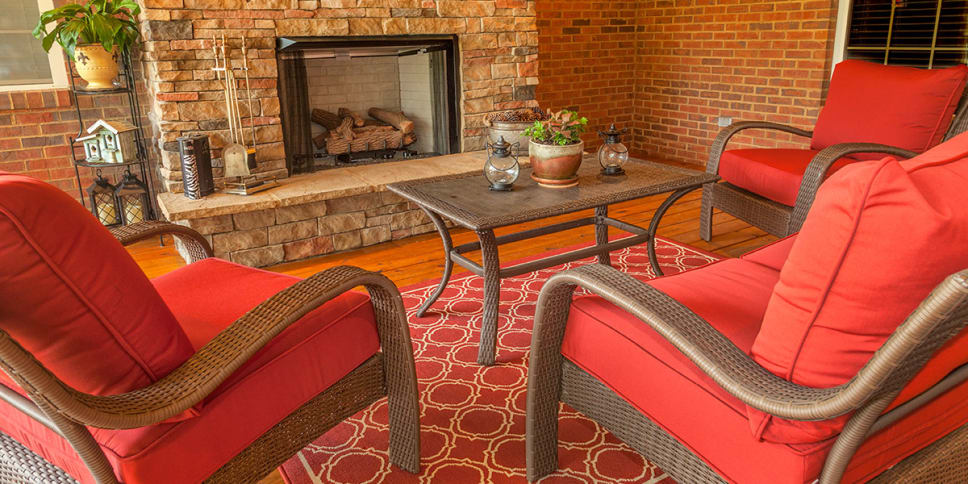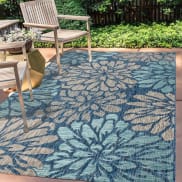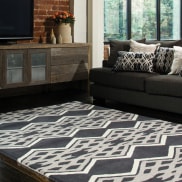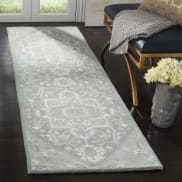How to Clean & Care for Outdoor Rugs
5 tips that will keep your outdoor rug looking new for years to come

Creating a functional outdoor space can make your living area feel much bigger. When it’s nice outside, it’s great to be able to flow outdoors with ease. Of course, a big part of creating a functional and inviting outdoor living area is to put together the perfect combination of furniture, lighting, and other patio décor.
Once you’ve created a comfortable environment for your patio or porch, the next challenge is to ensure that it stays clean and in good shape. Everyone remembers to clean the tables and chairs, but the outdoor rug often gets overlooked and neglected.
Below, we’ve listed out five essential cleaning tips to help you learn how to clean, maintain and care for your outdoor rug to keep it looking new for many years to come.
1. Think About the Material
The material that your rug is made of plays a big role in determining how you will need to clean it. There are a number of materials that are common for outdoor rugs. Here are a few of the most popular materials:
- Acrylic
- Bamboo
- Nylon
- Polyester
- Polypropylene
- Sisal
Of course, each of these materials have their own set of advantages, but because these rugs are designed to be outside, the materials used typically won’t be as plush as indoor rugs. Instead, the materials will be tougher and better prepared for the often extreme elements of the outdoors.
For the most part, you’ll find that outdoor rugs are made of either synthetic or natural materials.
- Synthetic materials tend to be bright in color, lightweight, quick to dry and able to get wet.
- Natural rugs are typically have a great texture and durability, but shouldn’t be exposed to as much moisture as synthetic materials.
If possible, try to locate a tag on the rug to determine what it is made of. If you can’t determine what the rug is made of, don’t worry too much about it. The main concern would be how long the rug remains moist.
2. Consider Its Location
Where you place your rug outdoors will also determine how long it will last, as well as how much care and maintenance you’ll need to provide. If the rug gets walked across often or is directly in the sun, it may be harder to keep it looking nice. Similarly, if your rug sits out on a patio or deck that is constantly moist, then it will likely end up wearing out sooner than it should.
To keep it looking new and easier to clean, consider placing your outdoor rug in a low-traffic area that will stay dry. Of course, this doesn’t mean that your rug can’t see any foot traffic, but it also doesn’t have to be located in an area that is right outside the door. After all, that’s what doormats are for.
That being said, if your rug is still going to be in a high traffic area, you should consider using one made of a more durable material. Certain rug materials are better at bouncing back from a lot of traffic. Polypropylene is a type of rug that works better in a low traffic area because it is not elastic, so it will likely get flattened from a lot of traffic. Sisal rugs, on the other hand, are better suited for high traffic areas. Even if you choose a rug that can do well with a lot of traffic, you can make it last longer by putting it in an area that won’t be walked on often.
3. Add a Waterproof Pad
Whether it’s indoors or outdoors, using a rug pad will help keep your rug looking better for a longer time. This essential accessory plays a crucial role in keeping the rug in place and protect the floors below. Just like the different rug materials available, there are different kinds of rug pads with diverse benefits and purposes.
Common Options Include:
- Carpet to Hard Floor Pad -- A thick pad made with a rubber tread underneath to help give both grip and cushioning while shielding from dirt.
- Felt Pad -- Made from a thick, padded fabric that does not provide grip but does protect from dirt.
- Waffle Pad -- Made of a soft, rubber material that provides minimal cushioning and protection but does prevent skidding.
The type of pad you decide to get will depend on what purpose you want your outdoor rug to fulfill. What’s important to keep in mind that if you are using this rug pad outside, that it should be waterproof (sometimes referred to as weatherproof). With all this in mind, you should be able to find both a rug and a pad to fulfill the role you need.
4. Damage Prevention
A large part of ensuring that your outdoor rug lasts as long as possible is to take certain measures that can help prevent damage in the first place. There’s no denying that the location of the rug will play a large role here, but there are certain steps you can take to help protect and preserve your rug.
- Cleaning spills as soon as they happen.
- Preventing dirt, dust or mildew build-up.
- Keep an eye out for insects or other pests.
- Storing the rug in a dry area when it’s cold and snowy.
If you decide to roll-up and store away the rug during cold or wet months, it may be wise to cover or wrap it with a lightweight fabric to allow it to breathe while also adding an extra layer of protection from insects or pests.
5. Cleaning Methods & Techniques
To better take care of your rug, it’s not only important that it is cleaned frequently to prevent mildew or excessive dirt from accumulating, but also to have a good understanding of how each type of material should or shouldn’t be cleaned. Here are a few cleaning techniques you should keep in mind.
- Disinfect -- Using diluted bleach can help you remove algae, mildew or mold that may have accumulated. A more natural cleaner would be to use diluted vinegar, but it’s important to note that you should never mix bleach and vinegar together.
- Blot, Never Scrub -- No matter what type of cleaning mixture you are using, when it comes to cleaning a rug or carpet, you should always use a blotting technique to remove stains. When you scrub, you are merely pushing stains deeper into the rug, making it more difficult to fully remove.
- Hose It Down -- Use your garden hose to spray off your outdoor rug. This will quickly remove larger items. However, depending on its location and temperature, it would be probably be wise to hang dry the rug to ensure that all moisture is removed.
- Scrape It: Being out in the elements, it’s not uncommon for dirt, mud, and other debris to just get stuck in the fibers of your outdoor rug. Try using a dull putty knife or some sort of scraper to gently break apart and remove large pieces of dirt or debris.
- Spot Treat: Tough stains may have to be spot-cleaned. Depending on the material, you can use warm soapy water or some other cleaner. But, again, it may be wise to hang dry to prevent mildew from forming.
- Shake it Out: Regularly shaking out your outdoor rugs will remove dirt. If left to collect in the fibers, dirt can grind into your rug making it harder to clean, and possibly even damaging it prematurely.
- Sweep Above (And Below): Cleaning off the top of your rug is obvious, and a broom is a great tool for this. The less-obvious area that you should clean, is to sweep the ground below your outdoor rug. This will help remove dirt and mildew -- possibly even insects -- from damaging the rug.
- Vacuum It: Another quick way to clean your outdoor rug of dust, dirt and smaller debris, is by vacuuming it. A regular vacuum cleaner will work here, but it may be wise to use a shop vac that is a bit more durable.
It is important you look at the care directions on the rug to make sure you are maintaining it in the right way. Not all rugs can get wet or be cleaned with bleach, so always be positive about the care instructions before your proceed.




